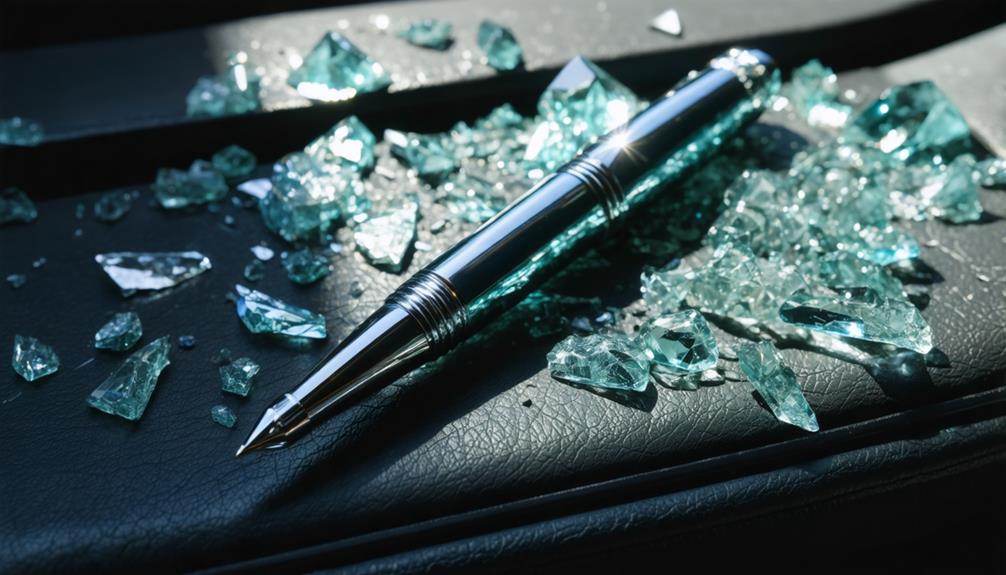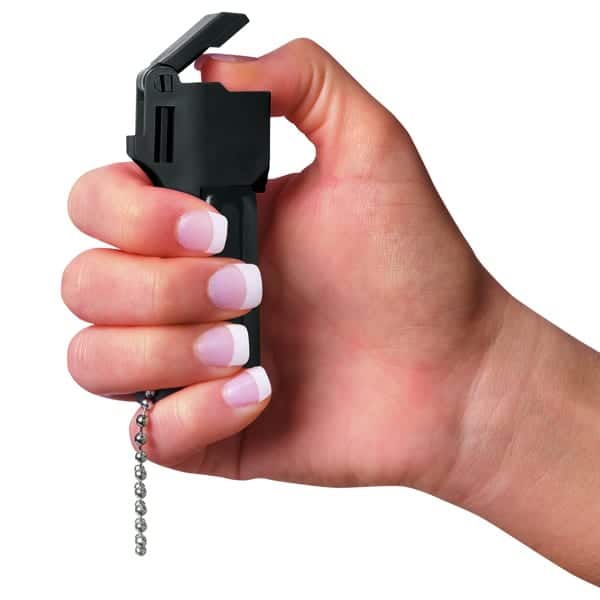
Brainstorm Security Shop

For Orders Over $199

On Any Of Our Products

Details On Refund Page
When it comes to self-defense, you might consider mace as a viable option for protection. This non-lethal tool, primarily made from oleoresin capsicum, can incapacitate an attacker momentarily, giving you a chance to escape. However, choosing the right product and understanding how to use it effectively is crucial for your safety. Legal restrictions can also play a significant role in your decision-making process. So, before you make a choice, it’s important to explore what you really need to know about mace and its implications for your personal safety.
Understanding mace and its composition starts with recognizing its primary ingredient: oleoresin capsicum, derived from hot peppers. This potent extract contains capsaicin, the compound responsible for its heat and effectiveness as a self-protection tool. When you use mace, you’re essentially deploying a powerful chemical irritant that can incapacitate an attacker temporarily.
Mace works by targeting the eyes, causing intense burning sensations, tears, and temporary blindness, which gives you the opportunity to escape a dangerous situation. It’s crucial to understand that mace isn’t just a deterrent; it’s a self-defense mechanism designed to provide you with a crucial advantage during an emergency.
In addition to oleoresin capsicum, mace often contains other ingredients like solvents and propellants, which help disperse the spray effectively. Knowing the composition of mace can help you feel more confident in its use.
Always remember that while mace can be an effective self-protection tool, it should be used responsibly and only in situations where you genuinely feel threatened. Understanding these elements helps you make informed decisions about your safety and self-defense strategies.
Using mace for self-defense offers several advantages that can enhance your personal safety. When you’re prepared and informed, you can effectively protect yourself in threatening situations. Here are three key benefits of using mace:
To maximize these benefits, invest time in training techniques that familiarize you with the product. Regular practice ensures you’re ready to respond effectively under pressure. Remember, understanding how to use mace properly can make a significant difference in your safety during critical moments.
How does mace effectively incapacitate an attacker?
Mace works by delivering a potent spray of chemicals that can temporarily blind and incapacitate an assailant. Upon contact, the active ingredients, often including pepper spray or tear gas, cause intense irritation to the eyes, throat, and skin. This immediate reaction can disorient your attacker, giving you precious seconds to escape.
The mace effectiveness lies in its ability to create a barrier between you and potential threats. It’s easy to carry, quick to deploy, and can be used from a distance, enhancing your safety. Unlike some mace alternatives, which may require close contact, mace allows you to maintain space between you and the attacker.
Furthermore, the effectiveness of mace can be heightened by practicing how to use it properly. Familiarizing yourself with its operation ensures you’re ready in a real-life situation. Remember, while mace is a powerful self-defense tool, it’s essential to remain aware of your surroundings and assess situations carefully. Knowing when to use mace, and understanding its capabilities, can make all the difference in protecting yourself effectively.
When you’re choosing the right mace product, you need to consider the different types available and their key features.
It’s also crucial to understand the legal considerations for using mace in your area.
Knowing these factors will help ensure you select a product that meets your self-defense needs effectively.
Choosing the right mace product can feel overwhelming with all the options available, but understanding the different types can simplify your decision. Mace products generally come in two main forms: spray and gel. Each has its unique benefits, so let’s break them down.
While selecting the right mace product, it’s crucial to consider key features that can enhance your safety and effectiveness.
First, think about the mace effectiveness; you want a product that delivers a strong and reliable spray. Look for options that specify a high concentration of active ingredients, as this can increase the likelihood of incapacitating an attacker in self defense scenarios.
Next, size and portability matter. A compact design makes it easier to carry, whether it’s in your purse or pocket, ensuring you’re prepared for any situation.
Also, check the spray range; a longer reach can help you maintain a safe distance from a potential threat, enhancing your safety.
Consider the type of nozzle as well. Some products offer a stream spray, while others might’ve a fog or cone spray, which can affect mace usage depending on the circumstances.
Lastly, pay attention to the product’s expiration date. An expired mace can compromise its effectiveness, leaving you vulnerable when you need it most. By keeping these features in mind, you’ll be better equipped to choose a mace product that meets your self defense needs.
Understanding the legal considerations surrounding mace use is essential for any self-defense strategy. Different states have varying laws regarding the legality of carrying and using mace, so it’s crucial to familiarize yourself with local regulations. Here are three key points to keep in mind:
Incorporating mace into your self-defense strategy can be effective, but you must be aware of the legal implications. Always prioritize responsible use and ensure you’re well-informed about local laws to protect yourself legally and physically. Remember, understanding these considerations is key to using mace effectively and safely.
When using mace for self-defense, you need to aim for the eyes to maximize its effectiveness.
Maintaining the right distance is crucial, as it allows you to deploy the spray without getting too close to your attacker.
Timing also plays a key role; striking when the situation demands it can make all the difference.
Precision is crucial in self-defense situations, especially when using mace. Your defensive strategy hinges on effectively incapacitating your attacker, and the eyes are the ideal target. Aiming for the eyes maximizes the blinding effects of mace, giving you the opportunity to escape. Here’s how to improve your aim:
Effective self-defense with mace isn’t just about aiming for the eyes; it’s also about mastering distance and timing. You need to understand your effective range, which generally falls between 6 to 10 feet. This distance allows you to deploy your mace while keeping the aggressor at bay. If you’re too close, you risk the chance of the attacker grabbing you or the mace itself.
Timing is equally crucial. You want to spray the mace when the attacker is within your effective range but not so close that they can counter your move. Watch for their reaction time, as it can be slower than you expect. This gives you a window to act.
Practice assessing distance in various scenarios. You can even use markers to simulate an attacker’s approach. The key is to remain calm and focused.
When the moment comes, take a deep breath, aim for the eyes, and spray. Remember, your goal is to create an opportunity for escape, not to engage further. Mastering distance and timing will make you a more effective and confident user of mace in self-defense situations.
Understanding the legal landscape surrounding mace for self-defense is crucial for anyone considering its use. Laws about mace can vary significantly from one state to another, so it’s essential to know the specific regulations in your area. Some states might allow you to carry mace freely, while others impose strict restrictions.
Here are three key legal considerations to keep in mind:
Being informed about these factors can help you avoid legal troubles while ensuring you’re prepared to defend yourself effectively. Always stay updated, as laws can change, and it’s your responsibility to comply.
Yes, mace can expire and lose effectiveness over time. Proper mace storage and maintenance are crucial. Check expiration dates regularly to ensure it’s ready when you need it and replace it if it’s expired.
Using mace on animals isn’t safe and can cause serious harm. You should prioritize pet safety and seek humane alternatives for deterring unwanted animal behavior. Always consider the well-being of your furry friends first.
To ensure proper storage and maintain effectiveness, keep your spray in a cool, dry place, avoiding temperature fluctuations. This way, you’ll extend its shelf life and ensure it’s ready when you need it most.
You can’t carry mace on an airplane due to legal restrictions. For public transportation, check local laws first. If you can’t bring it, consider alternative options like personal alarms or self-defense keychains. Stay safe!
If you accidentally spray yourself, seek fresh air immediately. Rinse affected areas with water for at least 15 minutes. Use first aid techniques for decontamination, avoiding rubbing your eyes or skin to reduce irritation.
